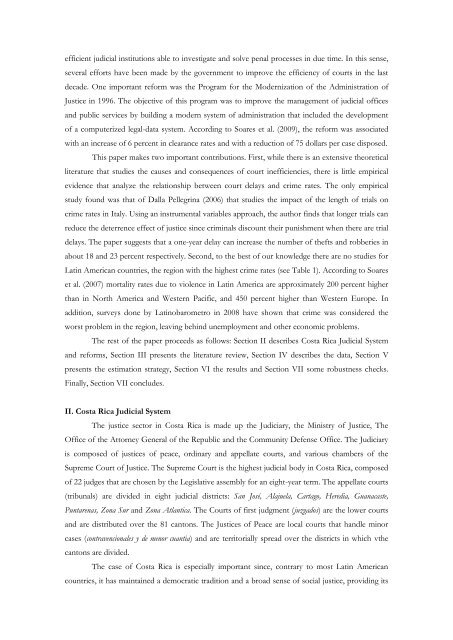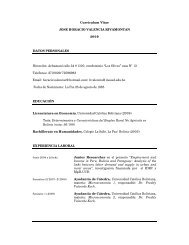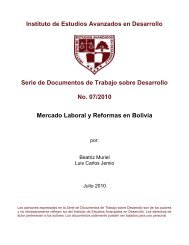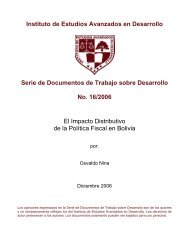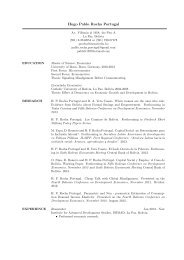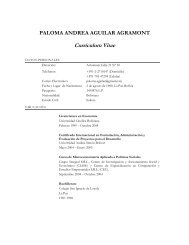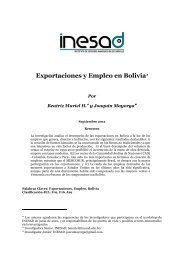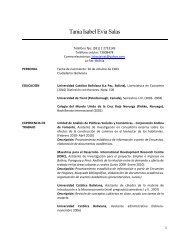Does Court Efficiency have a Deterrent Effect on Crime - inesad
Does Court Efficiency have a Deterrent Effect on Crime - inesad
Does Court Efficiency have a Deterrent Effect on Crime - inesad
You also want an ePaper? Increase the reach of your titles
YUMPU automatically turns print PDFs into web optimized ePapers that Google loves.
efficient judicial instituti<strong>on</strong>s able to investigate and solve penal processes in due time. In this sense,several efforts <str<strong>on</strong>g>have</str<strong>on</strong>g> been made by the government to improve the efficiency of courts in the lastdecade. One important reform was the Program for the Modernizati<strong>on</strong> of the Administrati<strong>on</strong> ofJustice in 1996. The objective of this program was to improve the management of judicial officesand public services by building a modern system of administrati<strong>on</strong> that included the developmentof a computerized legal-data system. According to Soares et al. (2009), the reform was associatedwith an increase of 6 percent in clearance rates and with a reducti<strong>on</strong> of 75 dollars per case disposed.This paper makes two important c<strong>on</strong>tributi<strong>on</strong>s. First, while there is an extensive theoreticalliterature that studies the causes and c<strong>on</strong>sequences of court inefficiencies, there is little empiricalevidence that analyze the relati<strong>on</strong>ship between court delays and crime rates. The <strong>on</strong>ly empiricalstudy found was that of Dalla Pellegrina (2006) that studies the impact of the length of trials <strong>on</strong>crime rates in Italy. Using an instrumental variables approach, the author finds that l<strong>on</strong>ger trials canreduce the deterrence effect of justice since criminals discount their punishment when there are trialdelays. The paper suggests that a <strong>on</strong>e-year delay can increase the number of thefts and robberies inabout 18 and 23 percent respectively. Sec<strong>on</strong>d, to the best of our knowledge there are no studies forLatin American countries, the regi<strong>on</strong> with the highest crime rates (see Table 1). According to Soareset al. (2007) mortality rates due to violence in Latin America are approximately 200 percent higherthan in North America and Western Pacific, and 450 percent higher than Western Europe. Inadditi<strong>on</strong>, surveys d<strong>on</strong>e by Latinobarometro in 2008 <str<strong>on</strong>g>have</str<strong>on</strong>g> shown that crime was c<strong>on</strong>sidered theworst problem in the regi<strong>on</strong>, leaving behind unemployment and other ec<strong>on</strong>omic problems.The rest of the paper proceeds as follows: Secti<strong>on</strong> II describes Costa Rica Judicial Systemand reforms, Secti<strong>on</strong> III presents the literature review, Secti<strong>on</strong> IV describes the data, Secti<strong>on</strong> Vpresents the estimati<strong>on</strong> strategy, Secti<strong>on</strong> VI the results and Secti<strong>on</strong> VII some robustness checks.Finally, Secti<strong>on</strong> VII c<strong>on</strong>cludes.II. Costa Rica Judicial SystemThe justice sector in Costa Rica is made up the Judiciary, the Ministry of Justice, TheOffice of the Attorney General of the Republic and the Community Defense Office. The Judiciaryis composed of justices of peace, ordinary and appellate courts, and various chambers of theSupreme <str<strong>on</strong>g>Court</str<strong>on</strong>g> of Justice. The Supreme <str<strong>on</strong>g>Court</str<strong>on</strong>g> is the highest judicial body in Costa Rica, composedof 22 judges that are chosen by the Legislative assembly for an eight-year term. The appellate courts(tribunals) are divided in eight judicial districts: San José, Alajuela, Cartago, Heredia, Guanacaste,Puntarenas, Z<strong>on</strong>a Sur and Z<strong>on</strong>a Atlantica. The <str<strong>on</strong>g>Court</str<strong>on</strong>g>s of first judgment (juzgados) are the lower courtsand are distributed over the 81 cant<strong>on</strong>s. The Justices of Peace are local courts that handle minorcases (c<strong>on</strong>travenci<strong>on</strong>ales y de menor cuantia) and are territorially spread over the districts in which vthecant<strong>on</strong>s are divided.The case of Costa Rica is especially important since, c<strong>on</strong>trary to most Latin Americancountries, it has maintained a democratic traditi<strong>on</strong> and a broad sense of social justice, providing its


